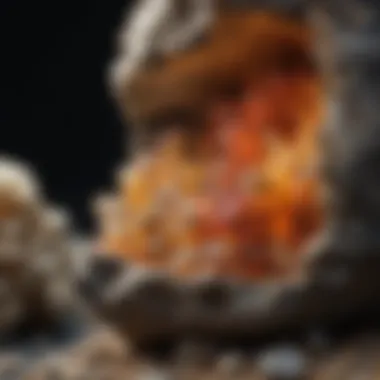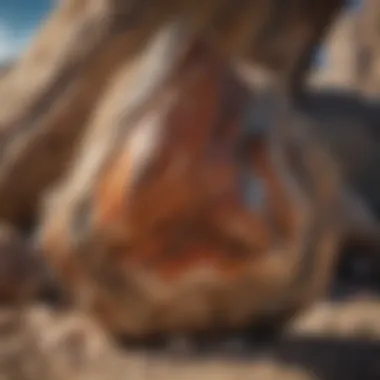Unveiling the Enigmatic World of Riker Mounts for Rock and Fossil Enthusiasts


Rock and Fossil Identification
Roker mounts tend to hold a precious place in the geological hearts of collectors around the world. Understanding the types of rocks and fossils found within these mounts is crucial. When identifying a particular rock or fossil, collectors should pay attention to specific characteristics that distinguish one specimen from another. Utilizing tools such as magnifying glasses, UV lights, and geology hammers can aid in the identification process.
Collecting Tips and Techniques
For aspiring rock and fossil collectors, mastering the art of collecting is a fundamental step. Adopting best practices, such as obtaining necessary permits and adhering to ethical guidelines, is essential. Locating prime collecting sites involves research and networking within the enthusiast community to discover hidden gems. When extracting specimens, it's vital to ensure the safety of both the collector and the geological treasure. Proper tools and techniques should be employed for extraction to prevent damage to the specimen or injury to the collector.
Preservation and Display
Preserving rocks and fossils is an art as much as a science. Techniques like consolidation, stabilization, and storage in archival-quality materials are imperative to maintain the integrity of the specimens. Effective preservation methods ensure that the beauty and scientific value of the rocks and fossils are retained for generations to come. When it comes to displaying these geological wonders, creativity knows no bounds. From elegant glass cases to interactive dioramas, there are myriad ways to showcase rocks and fossils that engage and inspire viewers.
Geological Insights
Exploring the geological facets of rocks and fossils provides a deeper appreciation for these natural wonders. Understanding the formations and processes that lead to the creation of rocks and fossils adds layers of intrigue to each specimen. Delving into the historical significance of certain rocks and fossils unveils a rich tapestry of Earth's past, offering insights into ancient environments and life forms. Notable discoveries in the field of geology continue to shape our understanding of the planet's dynamic history, with each find contributing to the collective knowledge of humankind.
Introduction
Amidst the expanse of the geological world lies a methodical system of display - Riker Mounts. These mounts serve as a quintessential element in the repertoire of rock and fossil collectors, enhancing the visual allure and preservation of their prized specimens. In this comprehensive guide, we intricately unravel the mystique shrouding Riker Mounts, paving the path for enthusiasts to elevate their curation practices and appreciation for geological marvels. By shedding light on the origins, composition, benefits, selection, and maintenance of Riker Mounts, this article embarks on a journey to demystify their significance in the realm of geological collection.
Understanding Riker Mounts
Origins and Significance
Riker Mounts trace their lineage to a rich tradition of geological exhibition, where the amalgamation of scientific precision and aesthetic finesse culminates in a hallmark of display. The origins of Riker Mounts can be attributed to the pioneering efforts of geologists and collectors, aiming to present specimens in their unadulterated form while preserving their pristine state. This historical legacy ingrained in Riker Mounts underscores their intrinsic value as not mere display utilities but as archival vessels of geological heritage. The significance lies in their ability to encapsulate the essence of Earth's history within a confined frame, offering viewers a tangible connection to the narrative of evolution etched in stone.
Composition and Structure
At the core of Riker Mounts lies a harmonious blend of functionality and elegance. Crafted from sturdy yet transparent materials such as glass or plastic, their structure ensures optimal visibility while providing a protective shield against external elements. The composition of Riker Mounts accentuates the specimens encased within, channeling focus towards the intricate details and unique characteristics of each rock and fossil. Their streamlined design and uniformity enable seamless integration into diverse display settings, from personal collections to museum exhibitions, amplifying the aesthetic appeal and educational value of the showcased specimens.


Benefits of Utilizing Riker Mounts
The benefits of incorporating Riker Mounts into geological collections encompass a spectrum of practical and aesthetic advantages. Firstly, Riker Mounts offer a secure environment for specimens, shielding them from environmental factors such as dust, moisture, and physical damage. This protective barrier not only contributes to the longevity of displayed rocks and fossils but also simplifies maintenance routines for collectors. Secondly, Riker Mounts enhance the visual presentation of specimens, elevating their allure through strategic positioning and artistic arrangement. By providing a minimalist yet sophisticated backdrop, Riker Mounts foreground the natural beauty of geological treasures, capturing the attention and fascination of viewers. Overall, the utilization of Riker Mounts transcends mere exhibition; it resonates with a dedication to precision, preservation, and presentation, embodying a holistic approach to rock and fossil curation.
Exploring Riker Mounts
In the realm of rock and fossil collection, delving into the intricacies of Riker mounts holds paramount significance. Not merely containers, Riker mounts serve as vessels carrying the essence of geological wonders, enabling enthusiasts to preserve and display their prized specimens with finesse. This section serves as a beacon, guiding collectors on the art of showcasing and safeguarding their treasures in a captivating manner. From selecting the ideal mount size to understanding the materials that enhance display aesthetics, each facet of exploring Riker mounts adds a layer of depth to the collector's journey.
Selection and Sizing
Choosing the Right Size
When it comes to choosing the right size for Riker mounts, precision is key in accentuating the magnificence of one's rock and fossil collection. The size of the mount should complement the dimensions of the specimens, ensuring a harmonious display that captivates the viewer's gaze. By selecting the optimal size, collectors can showcase their treasures with eloquence, allowing each specimen to shine in its own splendor within the confines of the mount.
Materials for Optimal Display
The materials utilized for optimal display in Riker mounts play a pivotal role in elevating the visual appeal of the specimens. From sturdy backings to transparent covers that shield against dust and damage, the choice of materials significantly influences the overall presentation. Selecting premium materials not only enhances the aesthetics of the display but also ensures longevity, safeguarding the specimens from environmental factors that could compromise their integrity.
Preparation and Placement
Cleaning and Arranging Specimens
A meticulous approach to cleaning and arranging specimens within Riker mounts is essential in preserving the authenticity and allure of each geological marvel. By gently dusting and strategically placing the specimens, collectors can create visually engaging displays that showcase the unique characteristics of each rock or fossil. The careful arrangement of specimens within the mount infuses a sense of artistry, inviting onlookers to appreciate the intricate details preserved within.
Strategic Positioning for Visual Appeal
Strategic positioning within Riker mounts amplifies the visual impact of the displayed specimens, drawing attention to notable features and textures. By understanding the principles of composition and visual hierarchy, collectors can arrange their specimens in a manner that harmonizes colors, shapes, and sizes. The thoughtful placement not only enhances the overall aesthetic but also guides the viewer's gaze, inviting exploration and appreciation of each individual specimen.
Preservation Techniques
Mitigating Environmental Impact


Efficiently mitigating the environmental impact on specimens housed in Riker mounts is crucial for their long-term preservation. By controlling factors such as light exposure, humidity levels, and temperature fluctuations, collectors can safeguard their treasures from potential deterioration. Implementing preventive measures against environmental threats ensures that the geological wonders maintain their splendor for generations to come.
Ensuring Longevity of Displays
Ensuring the longevity of displays goes beyond preserving the specimens themselves; it extends to maintaining the integrity of the entire exhibit. By utilizing archival-quality materials and adopting proper handling techniques, collectors can prolong the lifespan of their displays while retaining the pristine condition of the specimens. Attention to detail in display maintenance guarantees that each rock and fossil continues to enchant viewers with its timeless beauty.
Enhancing Display Aesthetics
In the intricate world of rock and fossil collection, the significance of enhancing display aesthetics cannot be overstated. A well-curated display not only showcases the beauty of geological specimens but also allows enthusiasts to appreciate the fine details and intricacies of each piece. In this comprehensive guide on Riker mounts, the section on Enhancing Display Aesthetics serves as a pivotal point in understanding the art of presentation and preservation within the realm of rock and fossil collecting.
Enhancing Display Aesthetics encompasses various elements that contribute to the overall visual appeal of a collection. From selecting the right mounting materials to strategically positioning specimens, each decision plays a crucial role in elevating the aesthetic value of the display. By exploring the nuances of presentation, collectors can create captivating showcases that inspire awe and fascination among viewers.
When delving into the realm of Artistic Presentation, one cannot overlook the importance of Incorporating Visual Elements. This aspect focuses on utilizing visual elements such as color, texture, and contrast to enhance the overall appeal of the display. By incorporating these elements thoughtfully, collectors can create displays that not only attract attention but also convey a deeper appreciation for the geological wonders being showcased. The meticulous arrangement of visual elements adds depth and dimension to the display, transforming it into a visual masterpiece that captivates the observer.
Furthermore, Creating Harmonious Arrangements plays a critical role in elevating the aesthetic quality of the display. This aspect emphasizes the importance of balance, symmetry, and composition in creating visually appealing arrangements. By carefully arranging specimens based on size, shape, and color, collectors can create harmonious displays that highlight the unique characteristics of each specimen while maintaining a cohesive visual appeal.
Riker Mount Maintenance
In the realm of rock and fossil collection, the maintenance of Riker mounts plays a pivotal role in ensuring the longevity and pristine condition of displayed specimens. An essential aspect of this article pertains to the meticulous upkeep of Riker mounts, which serves as the foundation for preserving geological wonders. By delving into the intricacies of Riker Mount Maintenance, enthusiasts are equipped with the necessary knowledge to safeguard their cherished displays from environmental wear and tear, underscoring the significance of proactive care.
Cleaning and Dusting
Among the paramount tasks within Riker Mount Maintenance is the regular cleaning and dusting of specimens. () Cleaning involves the removal of debris and dust accumulation that might obscure the clarity and beauty of showcased rocks and fossils. Through meticulous dusting, collectors elevate the visual appeal of their displays, allowing the geological wonders to shine vibrantly under the discerning gaze of admirers.
Best Practices for Maintenance
When considering the best practices for maintenance, a key aspect to prioritize is gentle handling and the use of appropriate cleaning tools. The meticulous approach to cleaning not only ensures the preservation of delicate specimens but also prevents deterioration due to abrasive cleaning methods. The meticulous utilization of soft brushes, microfiber cloths, and gentle cleaning solutions underscores the dedication to maintaining the integrity of each geological treasure on display. By adopting these best practices, collectors uphold the allure of their Riker mounts for generations to come.()
Tools and Techniques
Tools and techniques employed in the care of Riker mounts are essential components of effective maintenance routines. The selection of the appropriate tools, such as precision brushes, air blowers, and lint-free cloths, contributes significantly to the efficiency of cleaning endeavors. Moreover, the judicious application of techniques, like gentle swabbing motions and controlled air flow for dust removal, showcases the meticulous nature of Riker Mount Maintenance. These tools and techniques, when employed with precision and care, enhance the overall presentation of geological specimens without causing any damage, underscoring their indispensable role in curatorial practices.


Addressing Common Issues
Emerging common issues such as fungal growth and moisture accumulation pose significant challenges to the upkeep of Riker mounts and the specimens they house, necessitating targeted strategies for resolution. By proactively addressing these concerns, collectors can maintain the pristine condition of their displays and prevent irreversible damage to their prized geological collections.
Preventing Fungal Growth
A pervasive issue encountered in the care of geological specimens is the development of fungal growth, which can jeopardize the integrity of displayed rocks and fossils. Implementing preventative measures, such as adequate ventilation, controlled humidity levels, and routine inspection of mounts, serves as a proactive strategy to mitigate the risk of fungal proliferation. By fostering a dry and well-ventilated display environment, collectors can safeguard their treasures from the detrimental effects of fungal infestation, preserving the aesthetic and scientific value of their collections.
Dealing with Moisture
Moisture accumulation within Riker mounts poses a direct threat to the stability and preservation of specimens, necessitating immediate intervention to prevent irreversible damage. Effective strategies for managing moisture include the utilization of desiccants, ensuring proper ventilation around displays, and promptly addressing any sources of moisture ingress. By promptly addressing moisture-related issues, collectors can safeguard their collections from degradation and uphold the integrity of their geological wonders for continued admiration and study.
Utilization in Collections
In delving into the realm of Riker mounts within the context of rock and fossil collection, the utilization of these mounts plays a pivotal role. The utilization not only serves as a practical means of displaying geological wonders but also adds a layer of sophistication to the overall presentation. By incorporating Riker mounts into collections, enthusiasts can elevate the viewing experience, allowing for a closer inspection of each specimen. Moreover, the utilization of Riker mounts enables collectors to organize their displays in a systematic manner, enhancing the aesthetic appeal of their collection. The versatility of these mounts offers collectors the flexibility to adapt their displays based on themes or specific interests, contributing to a dynamic and engaging exhibition of geological marvels.
Organizing Display Themes
Curating Collection Themes
The art of curating collection themes holds substantial significance in the realm of rock and fossil curation. By focusing on specific themes such as geological eras, mineral types, or fossil categories, collectors can create a cohesive narrative within their displays. Curating collection themes allows enthusiasts to tell a compelling story through their exhibits, guiding viewers through a journey of geological discovery. One key characteristic of curating collection themes is the ability to evoke a sense of intrigue and education simultaneously. This method not only showcases the aesthetic appeal of specimens but also imparts valuable information to viewers, fostering a deeper appreciation for the world of rocks and fossils. Embracing curated collection themes in this article serves as a beneficial approach to engaging readers and enthusiasts alike, facilitating a deeper understanding of the diversity and beauty present in geological collections.
Showcasing Diversity
Showcasing diversity within display themes is fundamental to capturing the essence of geological variety. By highlighting a diverse array of specimens, collectors can showcase the vast spectrum of geological wonders available. The key characteristic of showcasing diversity lies in its ability to demonstrate the breadth of possibilities within rock and fossil collections. This approach is a popular choice for this article as it emphasizes the richness and complexity of geological treasures. By incorporating specimens from various geological periods, regions, and mineral compositions, showcasing diversity offers a comprehensive view of the Earth's geological heritage. While showcasing diversity enhances the visual appeal of collections, it also educates audiences on the intricacies of geological formations, making it a valuable addition to this comprehensive guide for rock and fossil collectors.
Conclusion
Final Thoughts
Embracing the Elegance of Riker Mounts
Embarking on the path of Embracing the Elegance of Riker Mounts bestows enthusiasts with an opportunity to showcase their specimens with unparalleled sophistication and clarity. The inherent elegance of these mounts lies in their ability to frame geological specimens like works of art, enhancing their visual allure and scientific value simultaneously. Choosing Riker mounts proves to be a judicious decision in this context, given their versatile nature and ability to complement and highlight the intrinsic beauty of each rock or fossil. The unique feature of Riker mounts lies in their ability to offer unobtrusive support while ensuring optimal visibility and protection for delicate specimens.
Fostering Appreciation for Geological Wonders
Fostering Appreciation for Geological Wonders entails instilling a profound sense of wonder and reverence for the Earth's remarkable treasures. This aspect underscores the educational and inspirational value of rock and fossil collections, encouraging enthusiasts to delve deeper into the geological marvels that adorn our planet. The key characteristic of this practice lies in its ability to connect individuals with the Earth's history and evolution, fostering a sense of stewardship and curiosity towards geological phenomena. While fostering appreciation, it is important to consider the role Riker mounts play in preserving these wonders for future generations to admire and study, ensuring that the narrative of Earth's geological story endures.







